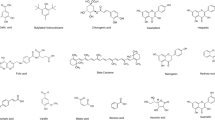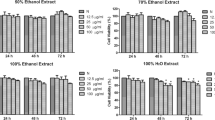Anti-angiogenic isoflavonoids are gaining attention as a novel approach in the prevention and treatment of tumor progression and metastasis. These phenylpropanoid compounds as bioactive phytoestrogens exhibit various pharmacological activities including antimicrobial, anti-inflammatory and antioxidant effects. The purpose of this study was to evaluate the anti-angiogenic, antioxidant and cell migration effects of prunetin in in vitro studies. The antioxidant activity of prunetin was performed against H2O2-induced cell damage on Vero cells. The cell migration effect was comparatively studied with HaCat cells. The anti-angiogenic potential of prunetin was assessed using an in vitro HET-CAM model. The strongest anti-angiogenic effect of prunetin was observed at 100 and 200 μM on the chorioallantoic membranes of hen eggs when compared to the control group. Similarly, the statistical analysis of data showed that prunetin treatment at 200 μM significantly induced cell migration with a ratio of 98.65 ± 0.46% on HaCaT cells. Additionally, the excessive protective effect of prunetin against H2O2-induced cytotoxicity in Vero cells was shown with 90% cell viability at the highest concentration. In conclusion, prunetin can stimulate keratinocytes migration and can induce antioxidant mechanisms which involves direct inhibition of the ROS generation and anti-angiogenic responses. It is suggested that prunetin can be applied to support anti-cancer treatment given its promising results since isoflavonoids possess antioxidant, anti-inflammatory and cell migration properties.





Similar content being viewed by others
References
K. M. Apaya, T. M. Chang, F. L. Shyur, Pharmacol. & Ther., 162, 58 – 68 (2016).
L. Wang, F. Yang, X. Zhao, et al., Food Chem., 275, 339 – 345 (2019).
D. Ribatti, History of research on tumor angiogenesis, Springer, DORDRECHT, Netherlands (2009), pp.1– 17.
C. Chen, Y. Wang, S. Chen, et al., Taiwan J. Obstetrics & Gynecology, 59, 403 – 408 (2020).
W. J. Bae, D. H. Kim, W. W. Lee, et al., J. Ethnopharmacol., 162,1–6 (2015).
H. S. Parekh, G. Liu, M. Q. Wei, Mol. Cancer, 20(8),1 – 21 (2009).
Y. Ling, Ann. Palliat. Med., 2(3),141–152 (2013).
V. Kuete, P. L. Sandjo, M. N. G. Kwamou, et al., Phytomedicine, 21(5), 682 – 688 (2014).
Z. Y. Zheng, G. Deng, R. Guo, et al., Phytochemistry, 166, 112075 (2019).
D. F. Birt, S. Hendrich, W. Wang, Pharmacol. Ther., 90(2–3), 157 – 177 (2001).
T. B. Clarkson, J. Nutr., 132(3), 566 – 569 (2002).
Y. Y. Liu, Q. J. Wu, Y. R. Fan, et al., Fish and Shellfish Immunol., 100, 238 – 245 (2020).
V. K. Sandhua, Y. E. Demiray, Y. Yanagawa, et al., Hormones and Behavior, 119, 104637 (2020).
H. Hu and H. Li, Biomed. & Pharmacother., 106, 1469 – 1477 (2018).
G. Yang, I. Ham, Y. H. Choi, Food & Chem. Toxicol., 58, 124 – 132 (2013).
K. C. Karayıldırım, A. Nalbantsoy, K. N. U. Yavasoglu, Mol. Biol. Rep.,1– 18 (2021).
T. T. Liao, Y. L. Shi, J. W. Jia, et al., Biomed. Environ. Sci., 23(3), 219 – 229 (2010).
N. Ammerman, M. Beier-Sexton, A. Azad, Curr. Protoc. Microbiol.,1– 10 (1998).
S. I. Kanno, A. Shouji, K. Asou, et al., J. Pharmacol. Sci., 92, 166 – 170 (2003).
J. H. Lee, T. K. Kim, M. C. Kang, et al., Food Biosci., 52, 102396 (2023).
R. P. Araldi, T. C. Melo, T. B. Mendes, et al., Biomed. Pharmacother., 72, 74 – 82 (2015).
C. C. Liang, A. Y. Park, J. L. Guan, Nature Protocols, 2(2), 329 – 333 (2007).
Q. Chen, L. Di, Y. Zhang, et al., J. Ethonopharmacol., 259, 112948 (2020).
L. Elberkirsch, R. L. Harzic, D. Scheglmann, et al., Eur. J. Pharm. Sci., 168, 106046 (2022).
L. Krenn and D. H. Paper, Phytomedicine, 16(12), 1083 – 1088 (2009).
J. Burgermeister, D. H. Paper, H. Vogl, et al., Carbohydr. Res., 337, 1459 – 1466 (2002).
S. R. Sulaiman, D. H. Basavarajappa, W. T. Corson, Exp. Eye Res., 129, 161 – 171 (2014).
V. P. Palacios, L. J. Robinson, C. W. Borysenko, et al., J. Biol. Chem., 280, 13720–7 (2005).
A. Bouslimi, C. Bouaziz, I. Ayed-Boussema, et al., Toxicology, 29(251),1–7 (2008).
C. Wang, L. Li, D. Fu, et al., Eur. J. Med. Chem., 176, 135 – 148 (2019).
A. Sarfraz, M. Javeed, A. M. Shah, et al., Sci. Total Environ., 722, 137907 (2020).
P. Joshi, G. S. Yadaw, S. Joshi, et al., South Afr. J. Botany, 130, 440 – 447 (2020).
I. Arranz-Valsero, L. Soriano-Romaní, L. García-Posadas, et al., Exp. Eye Res., 125, 183 – 192 (2015).
S. Galarza, H. Kim, N. Atay, et al., BioRxiv, doi: https://doi.org/10.1101/627281 (2019).
S. Shetty, S. Udupa, L. Udupa, Evidence Based Complement. and Alternat. Medicine, 5, 95 – 101 (2008).
S. Razia, H. Park, E. Shin, et al., J. Ethnopharmacol., 290, 115096 (2022).
I. S. Kamarazaman, N. A. M. Ali, F. Abdullah, et al., Arab. J. Chem., 15, 103871 (2022).
C. M. Nemitz, S. N. F. Fachel, A. Beckenkamp, et al., Industr. Crops & Products, 105, 193 – 202 (2017).
L. Elberkirsch, R. Le Harzic, D. Scheglmann, et al., Eur. J. Pharm. Sci., 168, 106046 (2022).
A. A. Öztürk, H. T. Kıyan, Microvasc. Res., 128, 103961 (2020).
G. Renda, N. F. Yalçın, E. Nemutlu, et al., J. Ethnopharmacol., 148, 423 – 432 (2013).
Acknowledgments
This study was supported by the Ege University Scientific Research Project (Project Number: FGA-2020-21853) and the Scientific and Technological Research Council of Turkey (TUBITAK, Grant no: 119Z028). The author would like to thank Dr. Jermaine Ma from the Department of Political Science, Bilkent University, Ankara, Turkey, for providing kind advice during drafting of this review.
Author information
Authors and Affiliations
Corresponding author
Ethics declarations
Conflict of interest
The authors declare no conflict of interest.
Ethical statements
Ethical approval was not required because the experiments were conducted using in vitro cell culture techniques.
Rights and permissions
Springer Nature or its licensor (e.g. a society or other partner) holds exclusive rights to this article under a publishing agreement with the author(s) or other rightsholder(s); author self-archiving of the accepted manuscript version of this article is solely governed by the terms of such publishing agreement and applicable law.
About this article
Cite this article
KARAYILDIRIM, Ç.K. In Vitro Evaluation of Anti-Angiogenic Efficacy, Cell Migration Activity and Cell Survival Effect Against Hydrogen Peroxide-Induced Damage of Prunetin. Pharm Chem J 57, 809–815 (2023). https://doi.org/10.1007/s11094-023-02950-w
Received:
Published:
Issue Date:
DOI: https://doi.org/10.1007/s11094-023-02950-w




